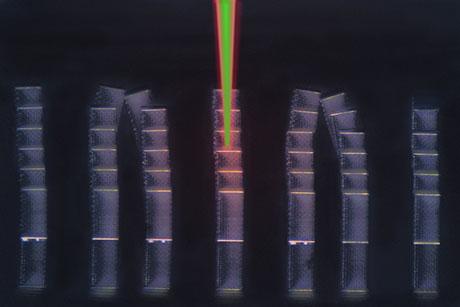Exploring Surfaces of Nanomaterials
Yang Shao-Horn is tackling the world’s energy problem by exploring — and manipulating — the surfaces of particles only billionths of a meter in diameter. Hundreds of thousands of these particles could fit on the period at the end of this sentence.
 “We are working to understand the surface chemistry and atomic structure of nanoparticles that help control key reactions relevant to clean and sustainable energy conversion and storage,” says the Gail E. Kendall Associate Professor of Mechanical Engineering and Materials Science and Engineering. Her work could lead to everything from better fuel cells — environmentally friendly energy storage devices — to state-ofthe-art batteries.
“We are working to understand the surface chemistry and atomic structure of nanoparticles that help control key reactions relevant to clean and sustainable energy conversion and storage,” says the Gail E. Kendall Associate Professor of Mechanical Engineering and Materials Science and Engineering. Her work could lead to everything from better fuel cells — environmentally friendly energy storage devices — to state-ofthe-art batteries.
Over the nine years Shao-Horn has been at MIT, the Electrochemical Energy Laboratory she directs has grown “to one with a research team of 20 students and postdocs,” she says.
Shao-Horn has made several key contributions to the field. These include the first images of atoms on and near the surface of nanoparticles key to the catalytic activity of oxygen chemistry that limits the efficiency of fuel cells. Chemical reactions catalyzed by these nanoparticles, composed of platinum and cobalt, run up to four times faster than reactions catalyzed by particles of platinum alone. Why?
Shao-Horn’s images show that the platinum and cobalt atoms form a sandwich-like structure, with platinum on the top followed by a layer of cobalt. Successive layers contain mixtures of the two. She and her team explain that the resulting nanoparticles are so active because the platinum ions on the surface are constrained by the cobalt atoms underneath.
Later, she showed that the nanoparticle surface is also important to its performance. By creating tiny stair steps on the surface of platinum nanoparticles, the team increased catalytic activity by 200 times over particles with smooth surfaces. “We find that the reaction happens at the step site,” Shao-Horn says.
Working with Paula Hammond, a professor of chemical engineering, Shao-Horn recently created a novel lithium battery composed only of carbon nanotubes, or cylinders of carbon only one atom thick. The battery produced up to 10 times the amount of power possible with a conventional lithium battery. The technology has been licensed to a company that aims to commercialize it, Shao-Horn says.
Much of her work is done with her “brilliant, committed” students, she says. “Over the years, I’m very much inspired by them to work here.”
Shao-Horn’s work could lead to everything from better fuel cells to state-of the-art batteries.![]()
Read the full article by Elizabeth Thomson at http://spectrum.mit.edu/articles/features/exploring-surfaces-of-nanomaterials/.


